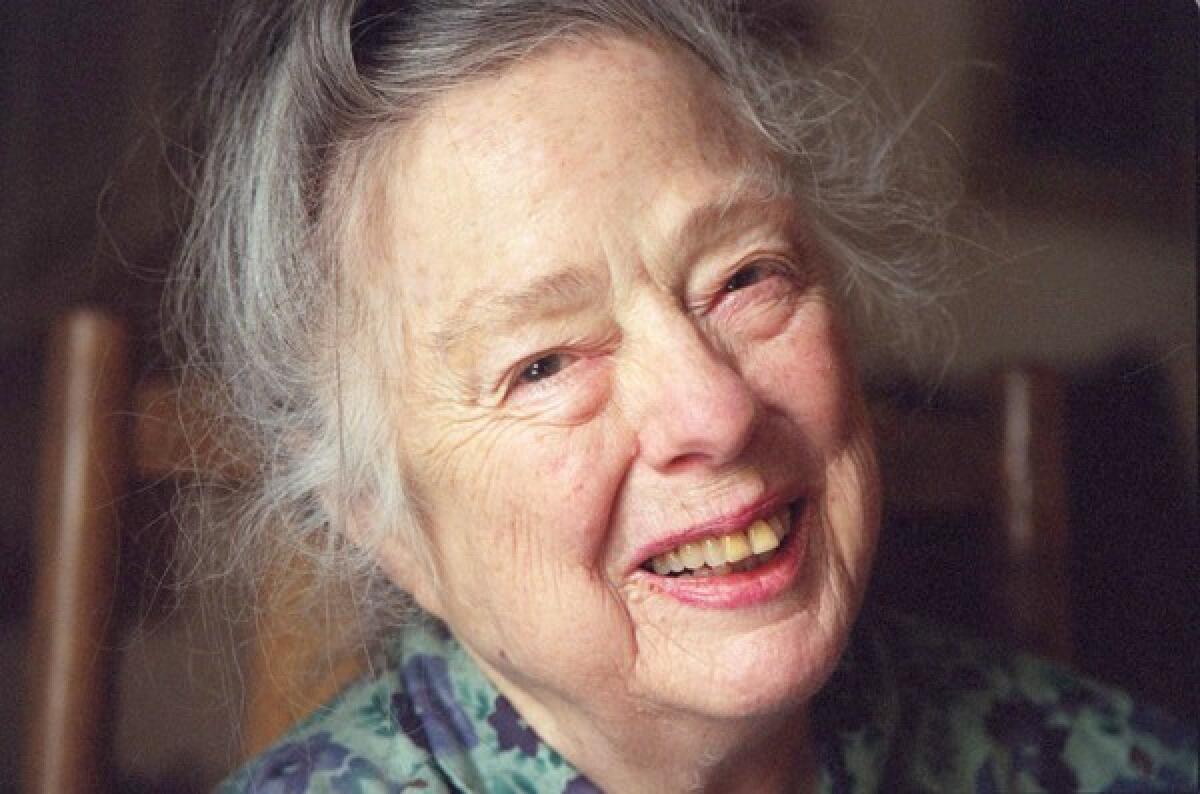Bess Lomax Hawes dies at 88; musician and folklorist

Bess Lomax Hawes, a musician and folklorist who tapped into the legacy of her influential family of archivists and became a prominent anthropologist at what is now Cal State Northridge, has died. She was 88.
Hawes, who directed folk and traditional arts programs at the National Endowment for the Arts from 1977 to 1992, died of natural causes Friday in Portland, Ore., where she had been living the last two years, her daughter Naomi Bishop said.
CSUN houses the Bess Lomax Hawes Student Folklore Archive, a collection of student research projects that Hawes oversaw. She was particularly interested in children’s folklore; among her documentary films is “Pizza Pizza Daddy-O,” showing black schoolgirls singing and clapping on a Pacoima playground in 1967. With Bessie Jones she made another film, “Georgia Sea Island Singers,” and they co-wrote “Step It Down: Games, Plays, Songs and Stories from the Afro-American Heritage” (1972).
“To me, it’s another way of getting to the human mystery -- why people behave the way they do,” Hawes said in a 2000 Times interview in explaining the value of studying folklore.
Steeped in folk music from birth, she was the youngest child of John A. Lomax and Bess Bauman Brown. Born Jan. 21, 1921, in Austin, Texas, she was home-schooled by her mother, who also taught her to play piano. Her father and her brother, Alan Lomax, collected seminal field recordings of traditional songs that had been sung by cowboys, prisoners and slaves.
After her mother died in 1931, the family moved to Washington, D.C., and Hawes assisted her father’s pioneering research compiling the folk song archive at the Library of Congress.
She graduated with a bachelor’s degree in sociology from Bryn Mawr College in 1941 and worked during World War II as a radio programmer for the Office of War Information. She was also one of a rotating crew of vocalists in the Almanac Singers folk ensemble, along with Pete Seeger, Woody Guthrie and her future husband, Baldwin “Butch” Hawes.
The couple married in 1943 and moved to Cambridge, Mass., where Hawes co-wrote the folk song “M.T.A.” that later became a hit for the Kingston Trio.
She also began a successful career as a music instructor.
“Everyone wanted to sing and play guitar like Bobby Dylan,” Hawes told the Daily News in 2002. “Folk music was a real postwar phenomenon. Everyone had either been tromped over or was out tromping over someone else during the war, and people were anxious to get back a sense of their roots.”
In 1952 Hawes and her husband, an artist, moved to California and settled with their children in Topanga Canyon, immersing themselves in the bohemian community anchored by actor Will Geer.
Besides performing in coffeehouses and at music festivals, Hawes taught guitar, banjo, mandolin and folk singing through UCLA Extension courses, at the Idyllwild summer arts program and, starting in 1963, at San Fernando Valley State College. She expanded her instruction to folklore, folk music and ethnomusicology and, after receiving a master’s in folklore from UC Berkeley studying under Alan Dundes, became head of the anthropology department at what is now CSUN.
Hawes began shifting from teacher to arts administrator in 1975 when she led a group of folk music and arts performers from California in a program on the National Mall presented by the Smithsonian Institution. The next year she participated in a bicentennial event staged by the Smithsonian, and in 1977 she joined the NEA.
She directed the national arts agency’s folk and traditional arts program and created the agency’s National Heritage Fellowships, which recognize traditional artists and performers from across the country. She retired in 1992 and the next year was awarded the National Medal of Arts by President Clinton.
To Hawes, folk art was “an identifier . . . a public statement of what a hell of a fine thing it is to be a Lithuanian or a Greek or a Comanche Indian . . . so that you feel good and people looking at the work will say, ‘That’s good,’ or ‘That’s beautiful,’ or ‘That’s different.’ ”
All three of Hawes’ children followed in her footsteps professionally. Her daughter Naomi Bishop of Portland, Ore., is a retired CSUN anthropology professor; another daughter, Corey Denos of Bellingham, Wash., is a teacher; and her son, Nicholas Hawes of Portland, Ore., is a folk musician.
Besides her children, Hawes is survived by six grandchildren and two great-grandchildren. Her husband died in 1971.
Services will be private.
More to Read
Start your day right
Sign up for Essential California for the L.A. Times biggest news, features and recommendations in your inbox six days a week.
You may occasionally receive promotional content from the Los Angeles Times.






